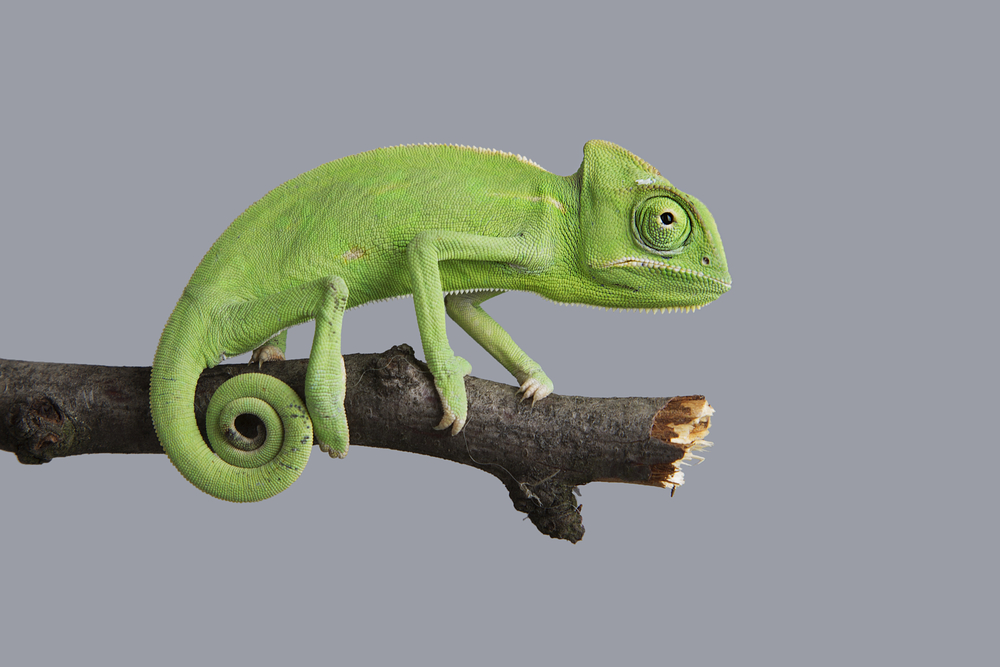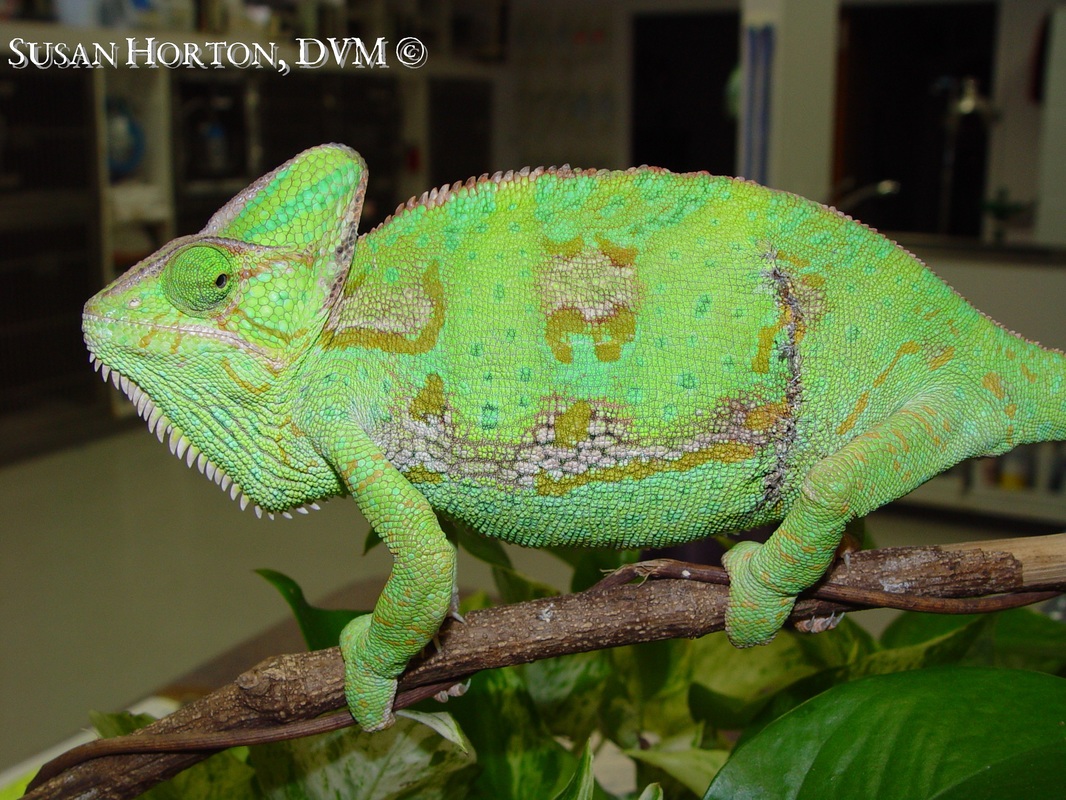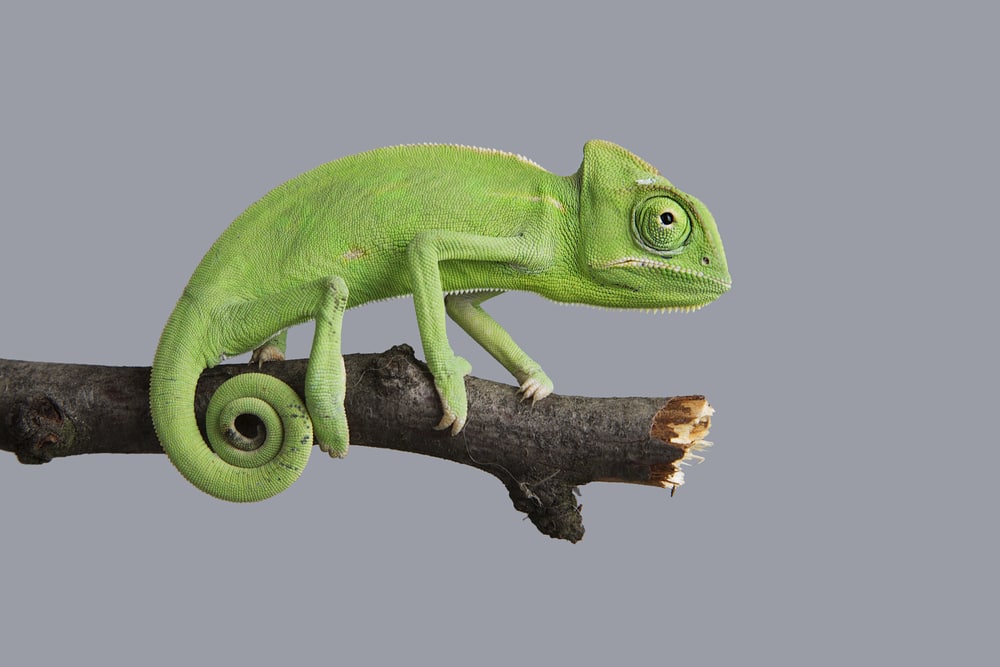Setting up a veiled chameleon cage requires space, ventilation, and proper lighting. Include climbing branches, foliage for hiding, and temperature gradients.
Veiled chameleons are arboreal reptiles that thrive in well-structured environments mimicking their natural habitat. A suitable enclosure should be tall and spacious, allowing these active climbers to navigate effectively. It’s essential to provide a mesh cage for maximum ventilation and to prevent respiratory issues.
The internal temperature should range from a warm basking area of about 85-95 degrees Fahrenheit to a cooler, shaded zone. Adequate UVB lighting is vital for calcium metabolism and overall health. Implementing a drip system or misting regularly will maintain the necessary humidity and provide drinking water for your chameleon. Remember to include non-toxic plants and branches, offering ample hiding spots and climbing opportunities, which are critical for the well-being of these exotic pets.
Meet The Veiled Chameleon

The veiled chameleon is a spectacle of color and charisma in the reptile kingdom. These captivating creatures boast a stunning array of colors, changing hues to communicate or reflect their moods. Ideal for experienced hobbyists, their care requires meticulous attention, creating a slice of their native environment right inside your home. Knowing the nuances of veiled chameleon care is essential for a happy, healthy reptile. Let’s embark on a journey to understand these colorful inhabitants and how to mimic their natural habitat for the perfect cage setup.
Colorful Inhabitants Of The Reptile World
Veiled chameleons stand out with their bold color patterns and crown-like casque. Colors range from vibrant greens and blues to yellows and browns. Their color-changing ability is truly mesmerizing. Each chameleon sports a unique pattern, a personal signature in their world. Adolescents often display more muted tones, blossoming into full color as they mature. These reptiles aren’t just eye-catching; they bring dynamic energy to any enclosure with their dramatic color shifts and graceful movements.
Natural Habitat And Behaviors
In the wild, veiled chameleons thrive in the mountainous regions of Yemen and Saudi Arabia. They prefer the coolness of high altitudes and the protection of leafy branches. Their natural behaviors include climbing and basking in dappled sunlight. A well-set-up cage replicates these conditions, providing ample climbing space with sturdy branches, and controlled lighting to simulate the sun’s rays. A drip system or frequent misting will ensure their hydration needs are met, echoing the morning dew of their natural habitat. Observing these behaviors can be fascinating, as it showcases their adaptation to the environment and survival instincts.
Creating the perfect habitat for a veiled chameleon involves understanding their wild behaviors and environment. The table below gives an at-a-glance guide to setting up your chameleon’s new home:
| Feature | Description |
|---|---|
| Cage Size | Minimum 2ft x 2ft x 4ft for adults |
| Lighting | UVB bulb for vitamin D synthesis |
| Temperature | 75-85°F daytime, 65-75°F night |
| Humidity | 50-70%, with proper ventilation |
| Foliage | Non-toxic plants and branches for climbing |
| Hydration | Drip system or regular misting |
With the right setup, a veiled chameleon can lead a long and healthy life under your care. Tailor the habitat to their needs, and you’ll enjoy the full spectrum of their colorful behavior in your own home.
Essential Cage Requirements
Creating the perfect home for a veiled chameleon is crucial for its health and happiness. Essential cage requirements are the keys to ensure your pet thrives. A well-set habitat mimics their natural environment and caters to their unique needs.
Size Matters: Spacious Living For Chameleons
Vast spaces are vital in a veiled chameleon’s enclosure. Reptile experts suggest that adult chameleons need large cages, at least 24 inches wide, 24 inches long, and 36 inches tall. Here’s what you need to know about cage size:
- Height is more important than width because chameleons love to climb.
- Young chameleons can start in smaller enclosures, but plan for future growth.
- A larger cage allows for temperature gradients, promoting healthy thermoregulation.
Choosing The Right Material For A Durable Home
The material of your chameleon’s cage makes a big difference. The best options are:
| Material | Benefits |
|---|---|
| Screen | Great ventilation, preferred choice. |
| Glass | Retains humidity, may need extra airflow. |
| Wood | Durable, but needs waterproofing. |
Select a cage that is easy to clean, resists rust, and stands the test of time. Remember, a flimsy cage can be a danger to your chameleon and a waste of money.
Climate Control Within The Cage
Creating the perfect climate inside a veiled chameleon cage is crucial. Veiled chameleons come from habitats that balance warmth and moisture expertly. Your cage needs to mimic these conditions for a healthy, stress-free chameleon. Let’s focus on temperature regulation and humidity control, two pillars of their well-being.
Temperature Regulation For Health And Comfort
Maintaining ideal temperatures encourages proper digestion and activity levels.
- Basking spot: Around 85-95°F (29-35°C)
- Ambient temperature: Should range between 72-80°F (22-27°C)
- Nighttime drop: Essential for rest with temperatures around 68-75°F (20-24°C)
Utilize thermostats and digital thermometers to keep conditions consistent.
Humidity: The Key To A Happy Chameleon
Chameleons need constant humidity for skin health and proper hydration.
| Time of Day | Humidity Level |
|---|---|
| Daytime | 50-70% |
| Nighttime | Up to 100% |
Achieve this with automatic misters or manual spraying. Remember to monitor with hygrometers for accuracy.

Credit: reptilesmagazine.com
Lighting: Simulating The Sun
Imagine your veiled chameleon basking in the bright light of their natural habitat. In captivity, creating a slice of their wild environment is crucial. Proper lighting in your chameleon’s cage plays a key role. It not only helps sustain their daily rhythm but is essential for their overall health.
Uvb Lights For Vitamin D Synthesis
UVB lighting is not just important, it’s a must-have for your chameleon. This invisible light allows your pet to produce Vitamin D3. This helps them absorb calcium and maintain a strong skeletal structure. Without UVB, your chameleon might face serious health issues.
Install a UVB bulb specifically designed for reptiles. Place it within 12 inches of the basking spot. Ensure it covers about two-thirds of the cage length. This allows your chameleon to move in and out of the light as needed.
Balancing Day And Night Cycles
Your veiled chameleon needs a balance between daylight and darkness. Aim for 12 hours of light and 12 hours of darkness each day. This mimics their natural cycle and supports their internal clock.
Use a timer to automate these cycles. Doing so promotes consistent lighting patterns. This, in turn, supports your chameleon’s health and well-being.
You may also consider adding a low wattage basking bulb for warmth. Place this at one end of the cage to create a temperature gradient. Your chameleon will appreciate this spot to heat up during the day.
The Jungle Canopy Effect
Welcome to the mystical world of the Veiled Chameleon, where replicating their natural habitat can lead to a happier, healthier chameleon. Creating a jungle canopy effect in your chameleon’s enclosure is key. This simulates their native environment, offering them the comfort and security they need for a thriving life.
Incorporating Foliage For Privacy And Security
Chameleons are private creatures. They value their solitude and enjoy blending into their surroundings. To give your chameleon its own secluded paradise, foliage is essential. Here’s how to do it:
- Use multiple plants: Mix different types and sizes to mimic the jungle’s layers.
- Varying heights: Place plants at different levels for climbing and hiding.
- Non-toxic vines and leaves: These provide additional coverage and climbing surfaces.
Safe Plant Choices For Your Chameleon’s Habitat
Select plants that won’t harm your chameleon if munched on. Not all plants are safe, so be careful. Here’s a list of safe options:
| Plant Type | Botanical Name | Common Name |
|---|---|---|
| Bromeliads | Bromeliaceae | Pineapple, Spanish Moss |
| Ferns | Polypodiopsida | Boston Fern, Maidenhair |
| Ficus | Ficus | Weeping Fig |
| Pothos | Epipremnum aureum | Devil’s Ivy |
Remember to research each plant and ensure it’s safe for your specific pet. Always wash plants before adding them to the cage to remove any pesticides. This setup creates a mini-jungle that allows your chameleon to feel at ease, explore, and enjoy its new habitat.
Scaling Up: Branches And Basking Spots
The ‘Scaling Up: Branches and Basking Spots’ section of your veiled chameleon’s cage is crucial. These cold-blooded companions need vertical space to climb and bask. A setup mimicking their natural habitat promotes healthy physical and mental development. Let’s craft a climber’s paradise and the perfect sunspot for them to thrive.
Creating Vertical Space For Climbing
Chameleons adore heights. Their safety and happiness depend on adequate climbing structures. Here’s how to optimize the cage:
- Use sturdy branches of varying thicknesses and lengths.
- Secure branches firmly to prevent falls.
- Connect branches to create multiple routes, offering exercise and exploration.
- Include live foliage for a natural grip and added humidity.
- Avoid sharp edges to protect delicate chameleon feet.
Locating The Perfect Basking Area
Basking is essential. Chameleons need warm spots to regulate body temperature. Placement is key:
- Position the basking spot above a stable branch.
- Ensure the basking light provides adequate warmth, usually around 85°F.
- Maintain a gradient, cooler areas allow your chameleon to cool down.
- Use thermometers to monitor temperatures in basking and resting areas.
- Provide a UVB light source for vitamin D3 synthesis.
Hydration And Feeding Essentials
Chameleons rely on specific conditions to stay hydrated and well-fed. Perfecting these conditions is key to a healthy pet. This section dives into the essentials of hydration and feeding, ensuring your veiled chameleon thrives in its new home.
Water Drip Systems For Natural Drinking
Chameleons prefer to drink moving water rather than from a stagnant source. A water drip system mimics this natural preference. It provides continuous water droplets on leaves, simulating rain. You can easily set up a drip system using:
- A clean water container,
- A control valve to adjust drip speed, and
- Placement above foliage to catch water.
Ensure the system’s end drips onto leaves where the chameleon can lick it off. Regularly check water levels and keep the system clean to avoid bacteria.
Varied Diet: Providing Nutrient-rich Insects
Veiled chameleons need a varied diet for optimal health. A mix of insects offers the nutrients they require. Include the following in their diet:
| Insect Type | Benefits |
|---|---|
| Crickets | High in protein |
| Worms | Rich in fat |
| Rolypolys | Calcium boost |
| Fruit Flies | For hatchlings |
Feed your chameleon once a day with five to twelve insects. Dust the insects with a calcium supplement bi-weekly. This ensures they get necessary vitamins and minerals. Remember, an overfed chameleon is at risk of health issues.
Maintenance And Hygiene
Maintenance and hygiene are crucial for a veiled chameleon’s health. A clean habitat prevents diseases and ensures your chameleon lives a happy, stress-free life. Regular upkeep is key. Learn how to maintain the perfect environment for your pet with these tips. Let’s dive into creating a hygienic home for your veiled chameleon.
Cleaning Schedules To Prevent Disease
Set frequent cleaning schedules to keep your chameleon’s cage a safe haven. This practice helps avoid health risks. Chameleons, like other reptiles, can fall ill due to unclean conditions.
- Daily: Remove uneaten food and waste
- Weekly: Clean and disinfect decor, and change out the substrate
- Monthly: Perform a deep clean of the entire enclosure
| Cleaning Task | Frequency |
|---|---|
| Spot Cleaning | Daily |
| Decor Disinfection | Weekly |
| Substrate Change | Weekly |
| Full Cage Clean | Monthly |
Monitoring Health: Common Signs Of Stress
Keep an eye on your chameleon for signs of stress and illness. Identifying them early on ensures your pet remains healthy. Common stress indicators include:
- Changes in color
- Lack of appetite
- Reduced activity levels
Examine your chameleon regularly. Look for physical changes or unusual behaviors. Contact a vet immediately if you notice:
- Labored breathing
- Swollen joints
- Visible wounds
Good hygiene and observation are your best tools. They ensure your veiled chameleon thrives in its habitat.
Cage Enhancements And Accessories
Creating a thriving habitat for your veiled chameleon involves more than just the basics. Beyond the essential enclosure, thoughtful enhancements and accessories can transform a simple cage into a stimulating and comfortable home. From interactive elements that encourage natural behavior to upgrades that cater to your chameleon’s growth, each addition plays a vital role in their wellbeing.
Interactive Elements To Stimulate Your Chameleon
Veiled chameleons thrive on interaction with their environment. To mimic their natural habitat, include a variety of plants and branches. These provide not only camouflage but also opportunities for climbing. A misting system can offer both hydration and a refreshing change in humidity, simulating a natural rainfall.
- Fake vines: Enhance climbing spaces
- Drip systems: Encourage natural drinking behaviors
- Feeding ledges: Offer a defined eating area
Upgrading Your Setup Over Time
As your chameleon grows, their needs change. Regularly assessing and upgrading the cage setup is crucial. Start with a versatile cage that can expand or be modified. Over time, introduce new accessories to enhance complexity and provide continued stimulation. Don’t forget to upgrade lighting and heating systems as needed to maintain optimal conditions.
Remember to check each accessory for signs of wear or damage. Replace items as they wear out to keep the environment safe and engaging.
- Larger basking stones: Meet growing size requirements
- New hides: Allow for privacy and stress reduction
- Advanced UVB lighting: Ensure adequate sun-like exposure

Credit: chameleonacademy.com
Common Mistakes To Avoid
Setting up a habitat for a veiled chameleon can be exciting. Yet, mistakes can cause harm. Here are blunders to steer clear of, ensuring your colorful companion thrives.
Overcrowding The Chameleon’s Space
Veiled chameleons cherish their solitude. These creatures are territorial and prefer living alone. Providing ample space is critical for their health and wellbeing.
- A single adult chameleon requires a minimum of a 2x2x4 feet cage.
- Multiples in one cage can stress them out, leading to health issues.
Always opt for a larger enclosure when possible. It allows for more climbing branches and foliage, imitating their natural habitat.
Neglecting Necessary Light And Heat Sources
Proper lighting and heating are essential for your chameleon’s health. UVB light helps them synthesize vitamin D3, crucial for calcium absorption. Without it, they risk metabolic bone disease.
| Light Type | Importance | Recommendation |
|---|---|---|
| UVB | Synthesis of Vitamin D3 | 10-12 hours daily |
| Basking Light | Warmth for digestion | 85-95°F hotspot |
An automated day-night cycle mimics their natural environment. Set timers for consistency. Regularly checking the cage temperature ensures a happy, healthy chameleon.
Step-by-step Assembly Guide
Welcome to the ultimate guide for assembling a Veiled Chameleon cage. Setting up a safe and stimulating environment for your reptilian pet is crucial. Follow this step-by-step assembly guide to create the perfect habitat. You’ll learn what supplies you need and how to put them all together systematically.
Gathering Your Supplies
Before assembling the cage, you must gather the right supplies. These essentials ensure your Veiled Chameleon thrives:
- Screened Cage: Promotes healthy air flow.
- UVB Lighting: Mimics natural sunlight, aiding in vitamin D3 synthesis.
- Basking Lamp: Provides heat for your pet’s thermoregulation.
- Thermometer & Hygrometer: Monitors temperature and humidity levels.
- Foliage & Branches: Creates hiding spots and climbing space.
- Substrate: Covers the floor, aiding in humidity control.
- Dripper or Misting System: Keeps your pet hydrated.
Gather these items before starting the assembly to ensure a smooth process.
Putting It All Together: A Systematic Approach
With your supplies ready, it’s assembly time. Start by setting up your chameleon’s new home:
- Assemble the cage framework by connecting the sides to the base and topping it with the roof.
- Secure the cage in a location away from direct sunlight and drafts.
- Install the UVB lighting and basking lamp, making sure to position them properly for your pet’s comfort.
- Place the thermometer and hygrometer inside the cage to keep an eye on the environmental conditions.
- Create a natural setup with foliage and branches for climbing and hiding.
- Lay the substrate on the cage floor for humidity control.
- Set up the dripper or misting system to provide your chameleon with a consistent water source.
Check everything is secure and functional before introducing your Veiled Chameleon to its new home.

Credit: www.exoticpetvet.com
Concluding With The Chameleon Care Commitment
Setting up a perfect home for a veiled chameleon is just the beginning. Owning this unique pet is a long journey. It comes with responsibilities. Let’s explore the commitment that every chameleon owner needs to embrace.
Long-term Responsibilities Of Chameleon Ownership
Owning a veiled chameleon isn’t just fun, it’s a serious commitment. Veiled chameleons need continuous care throughout their lives. Here’s what to expect:
- Regular Health Check-Ups: These ensure your chameleon stays happy and healthy.
- Dietary Management: Provide a variety of insects and supplements.
- Cage Maintenance: Clean the habitat regularly to prevent diseases.
- Environment Monitoring: Keep an eye on humidity and temperature daily.
Joining The Community Of Reptile Enthusiasts
Embrace the support of fellow reptile lovers. Here’s how you benefit:
- Experience Sharing: Learn from the successes and mistakes of others.
- Social Engagement: Find chameleon meet-ups and social groups.
- Support Networks: Get advice and support when you face challenges.
- Conservation Efforts: Contribute to protecting these amazing creatures.
Frequently Asked Questions On Veiled Chameleon Cage Setup
What Size Cage Does A Veiled Chameleon Need?
A veiled chameleon requires a tall cage—at least 36 inches high. A good size to aim for is 24x24x48 inches. This provides adequate space for climbing and proper air circulation. Smaller enclosures can stress the animal and lead to health issues.
How To Maintain Humidity In A Chameleon Cage?
To maintain proper humidity, mist the cage twice daily. Use a hygrometer to monitor levels, aiming for 50-70% humidity. Live plants and a drip system can also help in maintaining the desired humidity level and provide a naturalistic habitat for your veiled chameleon.
What Lighting Is Best For Veiled Chameleons?
Veiled chameleons require UVB lighting for vitamin D3 synthesis. They also need a basking light for warmth. Use a 5. 0-10. 0 UVB bulb and a basking bulb that creates a gradient, allowing the chameleon to thermoregulate by moving around the enclosure.
How Often To Clean A Veiled Chameleon’s Cage?
Clean your chameleon’s cage weekly to prevent bacterial growth and maintain health. Remove droppings, uneaten food, and shed skin daily. Provide a deep clean once a month, replacing substrates and sanitizing items to ensure a hygienic environment for your reptile.
Conclusion
Crafting the right habitat for your veiled chameleon is crucial. By focusing on the correct lighting, temperature, humidity, and foliage, you create a thriving environment. Remember, your pet’s health and happiness depend on a setup that mimics their natural habitat.
Tailor the cage to their needs and watch your colorful companion flourish.

